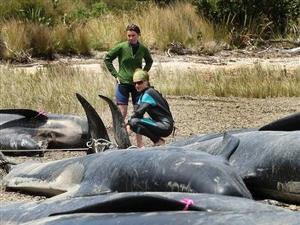TOKYO A Tokyo court on Wednesday convicted a New Zealand activist of assault and obstructing Japanese whaling ships in the Antarctic Ocean, and sentenced him to a suspended prison term.Peter Bethune was also found guilty on three other charges: trespassing, vandalism and possession of a knife. He had pleaded guilty to all but the assault charge when his trial started in late May.The court sentenced Bethune to two years in prison, with the sentence suspended for five years – meaning he will not be jailed.The assault conviction was for throwing bottles of rancid butter at the whalers aboard their ship, including one that broke and gave several Japanese crew members chemical burns.
Bethune, 45, climbed onto the Shonan Maru 2 in February from a Jet Ski to confront its captain over the sinking of a protest vessel the previous month. He slashed a protective net with a knife, which the court said he possessed illegally, to enter the ship.The former activist for Sea Shepherd, a U.S.-based conservation group, was held on board the ship and arrested when it returned to Japan in March.
The group has been protesting Japan’s whaling for years, often engaging in scuffles with Japanese whalers. Sea Shepherd claims the research whaling mission, an allowed exception to an international whaling ban, is a cover for commercial hunting.Judge Takashi Tawada said Sea Shepherd has been engaged in “acts of sabotage” against the whalers, and that the use of such violence should not be tolerated.
Bethune “assaulted the crew members and interfered with their mission and the impact was extremely serious,” Tawada said. “His actions are based on his selfish beliefs.”However, Tawada said there was room for leniency given that Bethune had acknowledged what had happened, indicated that he wouldn’t return to similar protest activities and had no criminal record in Japan.Bethune did not make a statement in court Wednesday, but flashed a message written on a notebook to his lawyers saying he wanted to go home as soon as possible, one of his attorneys said.The lawyer, who spoke on condition of anonymity due to fear of attacks by ultra-rightwing activists, said Bethune would not appeal the ruling. Bethune is expected to be deported within days.
In Wellington, New Zealand Foreign Minister Murray McCully welcomed Bethune’s suspended sentence. Arrangements have been made through consular officials for his return home, McCully’s spokesman, James Funnell, told The Associated Press.”What a relief all right,” Bethune’s wife Sharon said of the ruling. She credited her husband with raising awareness of Japanese whaling, but added, “We don’t want him to be doing it again, though.”In his tearful closing statement June 10, Bethune apologized for the trouble and said he never intended to hurt anyone.During earlier trial sessions, Bethune said he just wanted to confront the ship’s captain and hand him a $3 million bill for the destruction of the Ady Gil, a Sea Shepherd vessel that sank during a collision in January.Outside the court Wednesday, about 30 right-wing protesters chanted and held up placards, including one that said, “Give Sea Shepherd terrorist capital punishment.”Shuhei Nishimura, one of the protesters, called the sentence “too lenient.”Sea Shepherd recently said it expelled Bethune because he violated its policy against carrying weapons. The group said he had a bow and arrows with him while he was aboard the Ady Gil, although he never used them.
Still, on Wednesday, the group called Bethune “a hero” and said his mission helped save hundreds of whales which were to be killed by Japan.Sea Shepherd also said it is free to return to the Antarctic, vowing to be “more effective next season.”Japan, Norway and Iceland hunt whales under exceptions to a 1986 moratorium by the International Whaling Commission. Japan’s whaling program involves large-scale expeditions to the Antarctic Ocean, while other whaling countries mostly stay along their own coasts.
Separately, Japan has said the leader of Sea Shepherd, Canadian citizen Paul Watson, 59, is now on an Interpol wanted list for allegedly ordering Bethune’s actions as part of the group’s disruption of Japanese whaling in the Antarctic. Watson was placed on the Interpol list in late June at the request of Japan, which accuses his group of risking whalers’ lives during their expedition.(AP)





